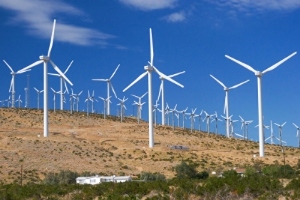
Google (NASDAQ: GOOG) is at it again. This time it’s showing corporate America that you can meet your bottom line, and you can do it all behind the use of clean energy.
The corporate world has never much cared about its carbon footprint — “we’ve got a business to run” — but increased pressure is being put on companies to seek alternative sources of energy that can benefit the environment and the world we live in.
Consumer awareness is at an all-time high. We read labels, we do our research, and we demand products and services that account for environmental factors. Those who aren’t listening and willing to make changes are only going to find themselves falling by the wayside.
It’s time to wise up, and Google is setting that precedent.
The Mountain View, California-based company has already spent more than $1 billion on 15 different wind and solar energy projects, and it says that 34 percent of its operations are now powered by renewable energy.
It is Google’s high hope and part of its mission that it will eventually be 100 percent powered by renewable energy; a goal that it could reach in the foreseeable future if it keeps with its current pace.
One investment, the Ivanpah Solar Electric Generating System, is the largest solar power plant in the world, and recently activated after Google invested $168 million in April, 2011, according to International Business Times. The solar thermal project produces 392 megawatts of electricity, or enough to power 140,000 homes in California.
Corporate Green
Google is a tree hugger’s dream — big-time corporate America that actually cares about the environment. But Google isn’t the only one with its sights set on clean energy.
There are three companies that already rely 100 percent on renewable energy and have proven its business efficiency.
Intel (NASDAQ: INTC)
Intel sources 100 percent of its electricity from renewable sources, and uses more clean energy in absolute terms than any other company. With its annual usage of 3,100,850,000 kWh, Intel is the king of renewable energy use in the corporate world.
It gets its power from third-party renewable energy credit providers, from utilities, and even produces some of its own, amassing clean power from biogas, biomass, small-scale hydro, solar, and wind power.
Intel’s commitment to renewable power has spurred the market for the entire renewables industry, and will remain a focal point as it continues to grow around the globe.
Green Mountain Coffee Roasters (NASDAQ: GMCR)
Coffee drinkers know about Green Mountain Coffee Roasters. Besides delivering a delicious cup of joe, it realizes the importance of being “green,” so much so that it’s part of the company’s name.
The company currently purchases or produces enough renewable energy to account for 120 percent of its annual 46,013,376 kWh of consumption, and it has no plans at stopping there. It is installing sub-meters and monitoring devices that will save energy across its supply chain, and it has created its own cost-per-sales metric, which showed a 17 percent drop in costs from 2011 to 2012.
Nokia (NYSE: NOK)
Nokia is another that is making the most of its 53,284,535 kWh of renewable energy that it uses annually. According to The Motley Fool, between the years of 2000 and 2010, Nokia cut its greenhouse gas footprint of its phones in half, and has further hopes of reducing its current footprint by 15 percent more by 2015.
It’s doing things on site that involve biogas, and aside from its electricity use, it’s implemented initiatives around the world to benefit the environment and its users.
These ten companies also run 100 percent on renewable energy:
Whole Foods (NASDAQ: WFM), Kohl’s (NYSE: KSS), TD (NYSE: TD), HSBC (NYSE: HSBC), Deutsche Bank (NYSE: DB), the Environmental Protection Agency, Mohawk (NYSE: MHK), Dannon, Pearson (NYSE: PSO, and The World Bank.
Companies like Wal-Mart (NYSE: WMT) have the same kind of goal in mind. It wants its store fronts and facilities to be 100 percent run by renewables in the future, and extend its carbon footprint to its fleet of trucks and the reduction of its greenhouse gas emissions.
Looking Forward
Making these changes may seem like a big, expensive burden. But that’s only up front. These changes will not only save money in the long run, but will benefit the world that we all share.
Companies like Google are very electricity intense, so the progress and use of renewable energy for companies of its magnitude is kind of a big deal.
With a full commitment the payoff could prove exponential.
Google just invested 480 million in six solar facilities in California and Arizona in November, according to International Business Times, and another $75 million for a windmill facility in Texas.
Google sees the potential.


